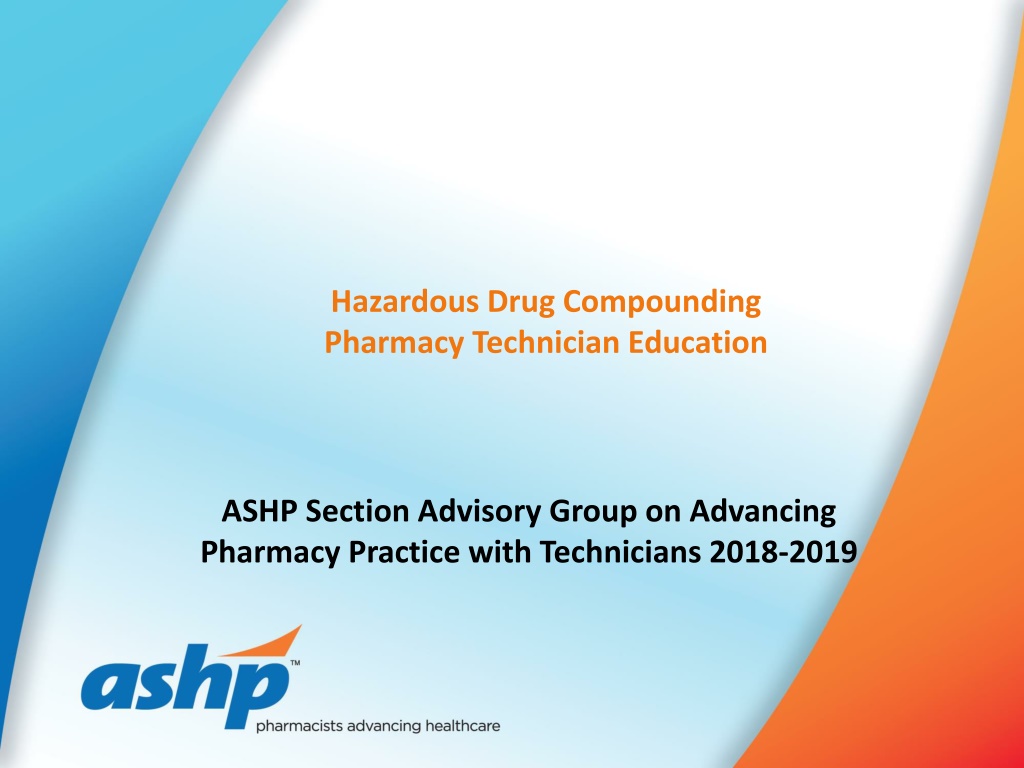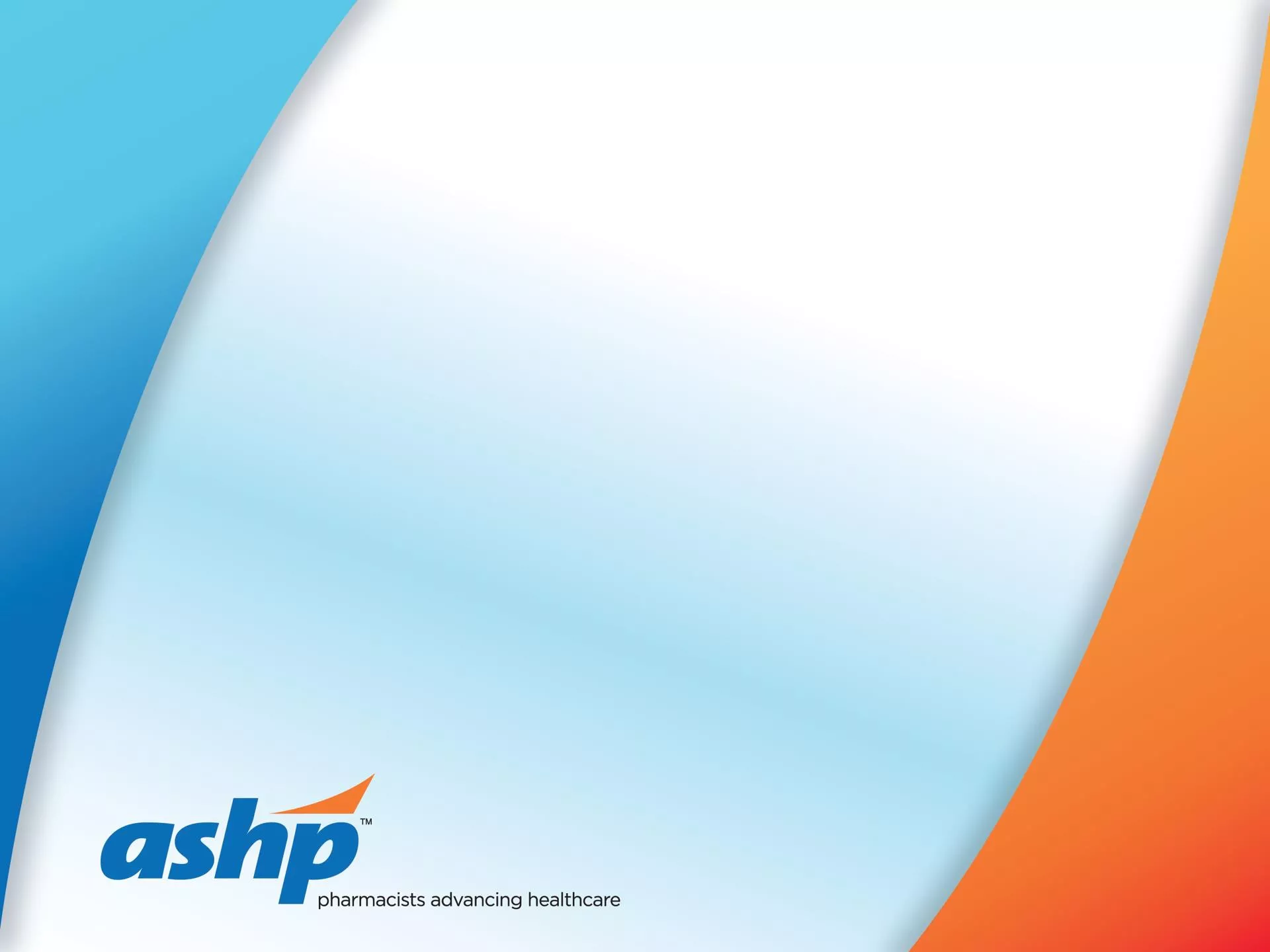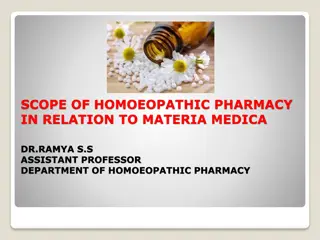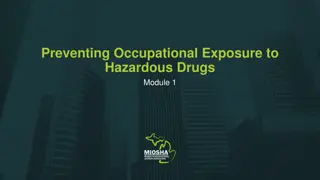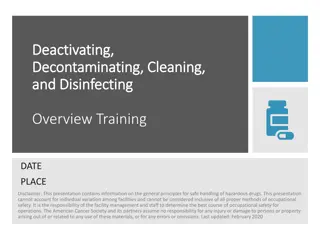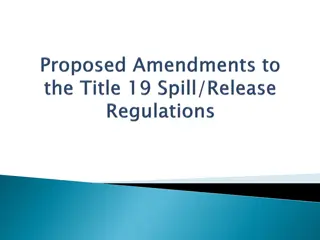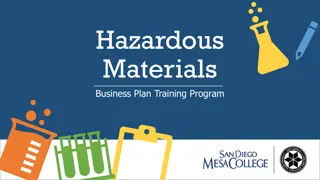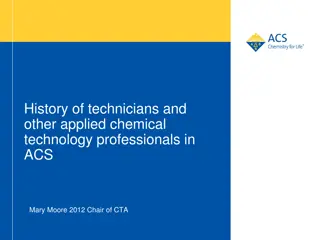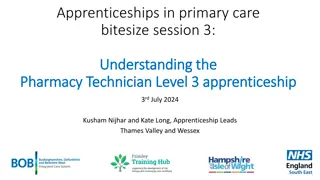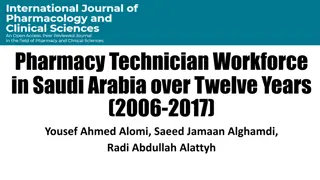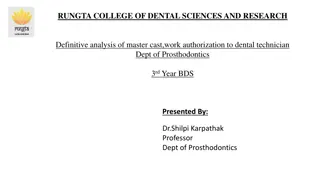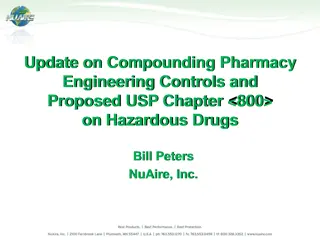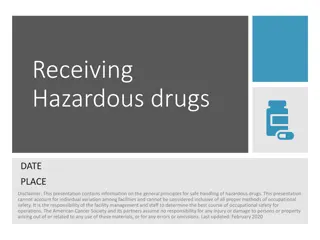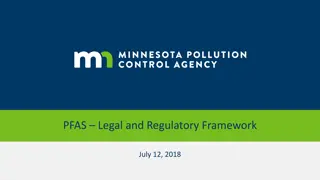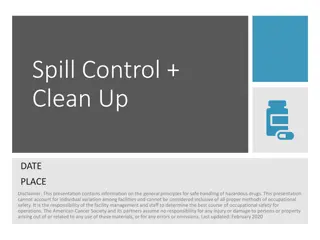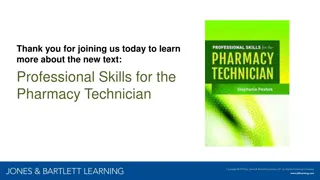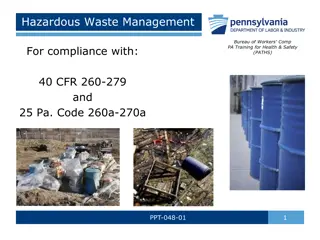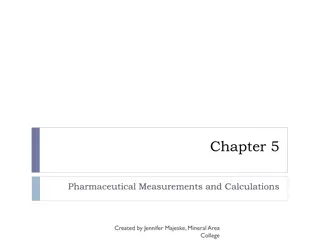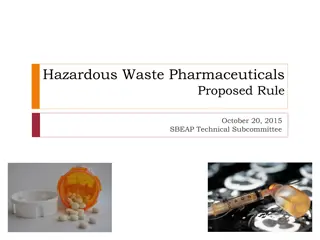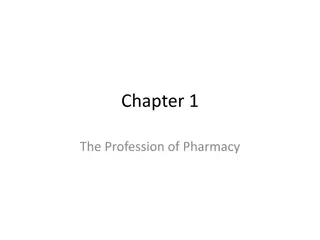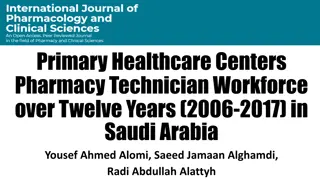Comprehensive Guide to Hazardous Drug Handling for Pharmacy Technicians
This guide covers essential aspects of handling hazardous drugs (HD) in a pharmacy setting, including types of HDs, risks associated with exposure, policies and procedures, ordering and stocking, personal protective equipment usage, aseptic practices, containment, and disposal procedures. It emphasizes the importance of following USP 800 guidelines, maintaining a facility HD list, and conducting regular risk assessments to ensure the safety of healthcare workers.
Download Presentation

Please find below an Image/Link to download the presentation.
The content on the website is provided AS IS for your information and personal use only. It may not be sold, licensed, or shared on other websites without obtaining consent from the author. Download presentation by click this link. If you encounter any issues during the download, it is possible that the publisher has removed the file from their server.
E N D
Presentation Transcript
Hazardous Drug Compounding Pharmacy Technician Education ASHP Section Advisory Group on Advancing Pharmacy Practice with Technicians 2018-2019
Table of Contents I. Didactic overview of types of hazardous drugs (HD) and their risks II. Review of hazardous drug policies and procedures including the process to request alternative duty III.Ordering, receiving and stocking of hazardous drugs IV.Hand hygiene V. Use of personal protective equipment (PPE) VI.Use of negative pressure techniques and closed system transfer devices (CSTDs) VII.Safe aseptic practices VIII.Containment, clean up, and disposal procedures IX.Treatment of personal contact and any unintended exposure to a HD
Overview Hazardous drugs (HD) are drugs that can cause adverse health effects if health care workers that handle (including distribution, preparation, or administration) these products are exposed to them Risks: acute and chronic health effects, adverse reproductive outcomes, cancers
Facility HD List USP 800 requires individual institutions to maintain a list of HDs Must include all products on the National Institute for Occupational Safety and Health (NIOSH) list which is separated into 3 categories Table 1: Antineoplastic HD Table 2: Non- antineoplastic HD Table 3: Reproductive Risks Ex) bleomycin Ex) cyclosporine Ex) colchicine Reviewed every 12 months Any new agent or dosage form used must be reviewed against the institution s hazardous drug list If insufficient information is available to classify a drug as hazardous or non-hazardous treat the drug as hazardous until further information is available
Policies and Procedures All staff, especially management, should ensure hazardous drug policies are readily accessible to staff and up to date Requests for alternative duty procedures should be addressed with the human resources department
Assessment of Risk (AOR) NOISH (National Institute for Occupational Safety and Health) puts out a list of hazardous drugs categorized into 3 tables Table 1: Antineoplastic Table 2: Non-Antineoplastic Table 3: Reproductive Risk A hospital must follow USP 800 containment strategies for All hazardous drug APIs (active pharmaceutical ingredients) Table 1 drugs that require further manipulation (ex. antineoplastic that has to be injected into an IV bag)
Assessment of Risk (AOR) A hospital can choose not to utilize all containment strategies listed in USP 800 if an the drug and dosage form meet criteria for one of the following and an AOR is conducted: Final dosage forms of compounded HD preparations and conventionally manufactured products (ex. oral chemotherapy that is only counted and repackaged into unit dose packaging) NOISH List Table 2 and 3 drugs AOR must document the alternative work practices are used for specific dosage forms to minimize occupational exposure and must be reviewed annually at minimum AOR must document the following considerations (at a minimum) Type of Hazardous Drug (NOISH categorization by Table) Dosage Form Risk of Exposure Packaging Manipulation
Ordering, Receiving, and Stocking Hazardous Drugs Ordering Establish with the suppliers that hazardous drugs should be received from the supplier in impervious plastic to segregate them from other drugs and to allow for safety in the receiving and internal transfer process.
Ordering, Receiving, and Stocking Hazardous Drugs Receiving Hospital must have a designated area for receipt and unpacking of hazardous drugs A sign designating the entrance to this hazardous drug handling area must be clearly visible This area must be away from a break room or area where food/drink are consumed Access to this designated receiving area must be restricted to authorized personnel Personal Protective Equipment (PPE), including chemotherapy gloves, must be worn when unpacking hazardous drugs. A spill kit must be accessible in the receiving area. Antineoplastics and HD APIs must be removed from their shipping container in a neutral or negative pressure area
Ordering, Receiving, and Stocking Hazardous Drugs Receiving (continued) Hazardous drugs should be removed from external shipping containers outside of sterile compounding or positive pressure areas The hospital must enforce policies that include a tiered approach, starting with visual examination of the shipping container for signs of damage or breakage (visual stains from leakage, sounds of broken glass). USP 800 outlines requirements for receiving and handling damaged HD shipping containers with specific directions that apply to if the shipping container appears damaged and if a damaged shipping container must be opened . Damaged shipping containers should be transported to a C-PEC designated for nonsterile compounding. If a C-PEC designated for sterile compounding is the only one available, it must be disinfected after the decontamination, deactivation, and cleaning step before returning to any sterile compounding activity. Hazardous drugs must be delivered to the hazardous drug storage area immediately after unpacking.
Ordering, Receiving, and Stocking Hazardous Drugs Stocking/storage Hospital must have a designated area for storage of hazardous drugs A sign designating the entrance to this hazardous drug handling area must be clearly visible This area must be away from a break room or area where food/drink are consumed Access to this designated receiving area must be restricted to authorized personnel Hazardous drugs must be stored in a way that prevents their spilling or breaking Hazardous drugs cannot be stored on the floor Antineoplastics requiring manipulation and HD APIs must be stored separately from non-hazardous drugs and should be stored in an externally ventilated, negative pressure room with at least 12 air pressure changes per hour (ACPH).
Ordering, Receiving, and Stocking Hazardous Drugs Stocking/storage (continued) Refrigerated antineoplastics must be stored in a dedicated refrigerator in a negative pressure area with at least 12 ACPH (storage room, *buffer room, or segregated compounding area are acceptable). Non-antineoplastic, reproductive risk only and final dosage forms of antineoplastic HD can be stored with other inventory (if allowed by hospital policy). Though sterile and nonsterile hazardous drugs can be stored together, nonsterile drugs should not be stored in sterile compounding areas to prevent increased traffic to these areas.
Hand Hygiene Hands must be washed with soap and water after removing gloves
Use of personal protective equipment (PPE) Purpose: To provide employees protection from hazardous aerosols and drug residue during preparation of products. Sites must have a policy identifying appropriate PPE to be worn Includes gloves and gowns
Use of personal protective equipment (PPE) Gloves Must be ASTM-tested chemotherapy gloves (ensure gloves being utilized are ASTM tested) Specific number D6978 Gloves must be powder free (powder may contaminate work area and can adsorb and retain hazardous drugs) and sterile Visually inspect gloves for defects prior to use. Do not use if defects seen. Two pairs of ASTM- tested chemotherapy gloves must be used when compounding, administering, managing a spill, and disposing of hazardous drugs. Outer glove must be sterile for sterile preparations Inner glove must be under the gown cuff and the outer glove must be over the gown cuff Gloves must be changed every 30 minutes, or when torn, punctured, or contaminated Discard of PPE in approved HD waste container inside C-PEC or contain them in sealable bag to discard outside the C-PEC
Use of personal protective equipment (PPE) Gowns Gowns must be worn when handling HDs Gowns must be able to protect worker from spills/splashes of HD and waste materials. These gowns must have been tested to resist permeability by HDs Disposable Polyethylene-coated polypropylene or other laminate materials offer better protection than uncoated materials Must close in the back. Front cannot be open. Must have long sleeves with closed cuffs that are elastic or knit. No seams or closures that could allow drugs to pass through Cloth material or other absorbent materials are not appropriate wear to handle HDs
Respiratory Protection Personnel who unpack HDs that are not contained in plastic should wear an elastomeric half-mask with a multi-gas cartridge and P100 filter PAPR should be worn when there is a risk of respiratory exposure to HDs, including: An HD spill that cannot be contained to a spill kit Any exposure underneath the work surface of a C-PEC When there is risk of airborne exposure to powders or vapors
Activity Gloves Gown Hair, Mask, Beard, Shoe Covers Eye Protect ion Respiratory Protection Receiving of intact product Receiving of broken products Transporting hazardous drugs Receiving product in compounding areas Stocking compounding areas Non-sterile compounding Sterile compounding Administering Routine clean-up Collection and disposal of patient waste Spills
Closed System Transfer Devices (CSTDs) A supplemental engineering control used in conjunction with primary and secondary control strategies. A drug transfer device that mechanically prohibits the transfer of environmental contaminants into the system and the escape of HD or vapor concentrations outside of the system CSTDs limit the potential for generating aerosols during compounding There is no universal performance protocol by which all CSTDs are evaluated for containment Users should carefully evaluate the performance claims associated with available CSTDs
Closed System Transfer Devices (CSTDs) Work practices that must be followed: CSTDs used as a supplemental control for compounding shall be used inside a C-PEC CSTDs should be used when compounding HDs when the dosage form allows CSTDs shall be used when administering HDs when the dosage form allows
Safe Aseptic Practices Using Negative Pressure Technique Perform all manipulation of HDs in Containment Primary Engineering Control (C-PEC) Observe proper material handling practices before introducing any item into the ISO Class 5 C-PEC Remove any unnecessary supplies Decontaminate the deck between different types of HDs Disinfect the deck with sterile 70% IPA Disinfect each component immediately before introduction to the C-PEC Arrange items so not to impede first air Open items to the left or right of direct compounding area Swab the vial septum with sterile 70% IPA and allow to dry Perform manipulations in the direct compounding areas and in a way in which critical sites remain in unobstructed HEPA filtered air (first air) Use a syringe that is 25% larger than the total dose Carefully attach the needle and syringe being careful to avoid touch contamination of either critical site Draw up the amount of air that is equal to the total dose to be drawn up
Safe Aseptic Practices Using Negative Pressure Technique (continued) Insert the needle into the septum being mindful of the first air coming down from the top of the C-PEC Without touching the length of the plunger and with the needle above the fluid level, pullback on the plunger slightly to create a negative pressure within the vial Invert the vial and with needle below the fluid level, withdraw no more than 15- 25% of the dose into the syringe, until you feel resistance. Slowly transfer small amounts of the medication into the syringe as equivalent amounts of air are exchanged for fluid Each time allow the syringe plunger to return to original position and never let plunger go above that original position (as it may result in positive pressure) Repeat these steps until the total volume is drawn up. With the needle still in the vial, remove all air bubbles and adjust to the final dose Once the final dose is measured, lace the vial upright on the deck and withdraw a slight amount of air through the needle to clear the hub of the syringe of drug. No additional air should be drawn into the syringe. Carefully withdrawal the needle and syringe from the vial Follow proper material handling procedures for removing hazardous compounded sterile preparations for the C-PEC
Containment, clean up, and disposal procedures Considerations: Agents used need to be appropriate for the surface material and type of HD How to apply? Use wet wipes with appropriate solution Do not use spray bottles to avoid spreading HD Make sure area is well ventilated and wear appropriate PPE
Containment, clean up, and disposal procedures
Containment, clean up, and disposal procedures Steps of Cleaning Process Deactivation goal of complete surface deactivation Decontamination remove HD residue from all surfaces When? Wipe containers before compounding in hood to reduce residue Decontaminate at least daily, w/ any spill, between compounding of different HDs, before/after certification, after hood is turned off, when ventilation tool is moved Cleaning removal of contaminants, not to be done while compounding is occurring Disinfection (for sterile compounding) last step, areas must be cleaned first; inhibits microbial growth Frequency of cleaning process
Containment, clean up, and disposal procedures Equipment used in HD compounding daily (decontamination, cleaning) or after each use Treatment of personal contact and any unintended exposure Direct skin or eye contact requires immediate evaluation Spill Control Proper training spill management and PPE/respiratory equipment Tend to immediately by qualified personnel Spill kits available in all areas where HDs are Received, stored, compounded, prepared, handled, disposed of Dispose of spill kit contents in hazardous waste containers Documentation of event & follow up for future prevention Definition of a spill - Internal policies to instruct on size of spill & scope for clean up Definition of an exposure event
Containment, clean up, and disposal procedures: Disposal Must consider and plan for disposal of different materials Trace hazardous waste Containers/tubing with <3% by weight of HD remaining All disposable supplies involved in compounding or cleaning PPE used in compounding Bulk hazardous waste Containers/tubing w/ >3% by weight of HD remaining Significantly contaminated supplies and PPE used in compounding, cleaning, etc Materials used in cleaning up spills
Treatment of Personal Contact and Any Unintended Exposure Personnel who are potentially exposed to a HD or who have direct skin or eye contact require immediate evaluation The occurrence of exposure-related health changes should prompt immediate reevaluation of primary preventive measures Perform post-exposure evaluation tailored to the type of exposure Compared performance of controls with recommended standards Conduct environmental sampling Verify all engineering controls are in operating conditions Develop an action plan to prevent future exposures
References The Pharmaceutics and Compounding Laboratory. https://pharmlabs.unc.edu/labs/parenterals/vial.htm. Accessed May 13, 2018. CriticalPoint. Pharmacy OneSource Blog. Clinical Corner: Leveraging Technology to Prevent Catheter-Associated Urinary Tract Infections (CAUTI). http://blog.pharmacyonesource.com/negative-pressure-compounding.-written-by- critical-point. Accessed November 13, 2018. Power LA. Closed-System Transfer Devices for Safe Handling of Injectable Hazardous Drug. https://www.pharmacypracticenews.com/download/CSTD_ppn0613_WM.pdf. https://www.pharmacypracticenews.com/download/CSTD_ppn0613_WM.pdf. Published June 2013. Accessed November 13, 2018. The National Institute for Occupational Safety and Health (NIOSH). Centers for Disease Control and Prevention. https://www.cdc.gov/niosh/topics/hazdrug/default.html. Published November 5, 2018. Accessed November 13, 2018. U.S. Pharmacopeia. USP. http://www.usp.org/. Accessed November 13, 2018. Wilson JP, Solimando DA. Aseptic technique as a safety precaution in the preparation of antineoplastic agents. Hospital Pharmacy. 1981;100:565-566.
